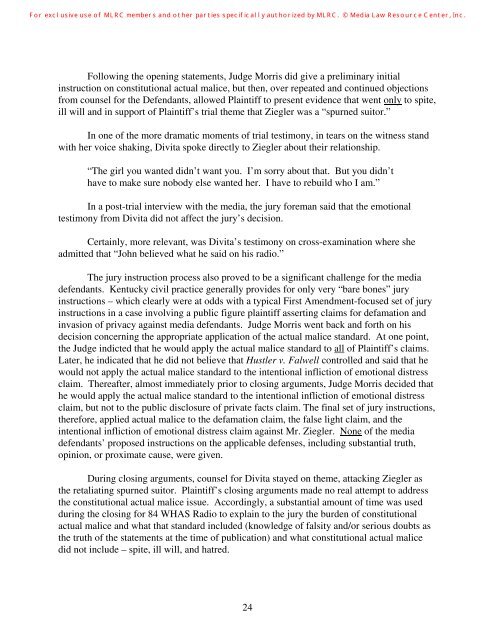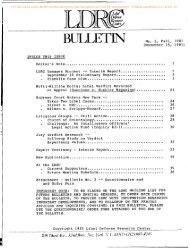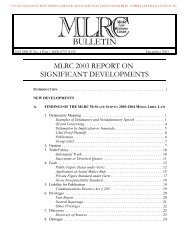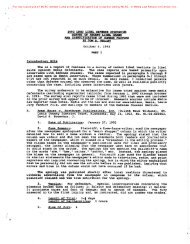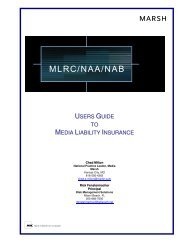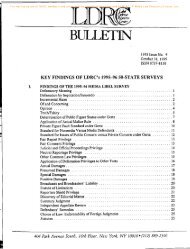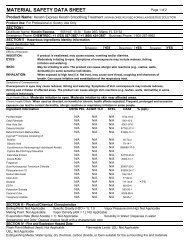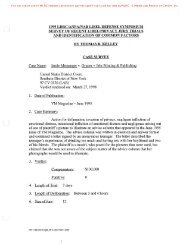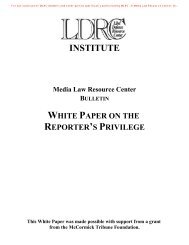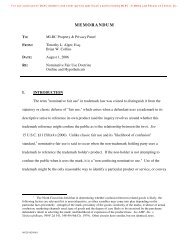2006 MLRC/NAA/NAB LIBEL DEFENSE ... - Directrouter.com
2006 MLRC/NAA/NAB LIBEL DEFENSE ... - Directrouter.com
2006 MLRC/NAA/NAB LIBEL DEFENSE ... - Directrouter.com
Create successful ePaper yourself
Turn your PDF publications into a flip-book with our unique Google optimized e-Paper software.
For exclusive use of <strong>MLRC</strong> members and other parties specifically authorized by <strong>MLRC</strong>. © Media Law Resource Center, Inc.Following the opening statements, Judge Morris did give a preliminary initialinstruction on constitutional actual malice, but then, over repeated and continued objectionsfrom counsel for the Defendants, allowed Plaintiff to present evidence that went only to spite,ill will and in support of Plaintiff’s trial theme that Ziegler was a “spurned suitor.”In one of the more dramatic moments of trial testimony, in tears on the witness standwith her voice shaking, Divita spoke directly to Ziegler about their relationship.“The girl you wanted didn’t want you. I’m sorry about that. But you didn’thave to make sure nobody else wanted her. I have to rebuild who I am.”In a post-trial interview with the media, the jury foreman said that the emotionaltestimony from Divita did not affect the jury’s decision.Certainly, more relevant, was Divita’s testimony on cross-examination where sheadmitted that “John believed what he said on his radio.”The jury instruction process also proved to be a significant challenge for the mediadefendants. Kentucky civil practice generally provides for only very “bare bones” juryinstructions – which clearly were at odds with a typical First Amendment-focused set of juryinstructions in a case involving a public figure plaintiff asserting claims for defamation andinvasion of privacy against media defendants. Judge Morris went back and forth on hisdecision concerning the appropriate application of the actual malice standard. At one point,the Judge indicted that he would apply the actual malice standard to all of Plaintiff’s claims.Later, he indicated that he did not believe that Hustler v. Falwell controlled and said that hewould not apply the actual malice standard to the intentional infliction of emotional distressclaim. Thereafter, almost immediately prior to closing arguments, Judge Morris decided thathe would apply the actual malice standard to the intentional infliction of emotional distressclaim, but not to the public disclosure of private facts claim. The final set of jury instructions,therefore, applied actual malice to the defamation claim, the false light claim, and theintentional infliction of emotional distress claim against Mr. Ziegler. None of the mediadefendants’ proposed instructions on the applicable defenses, including substantial truth,opinion, or proximate cause, were given.During closing arguments, counsel for Divita stayed on theme, attacking Ziegler asthe retaliating spurned suitor. Plaintiff’s closing arguments made no real attempt to addressthe constitutional actual malice issue. Accordingly, a substantial amount of time was usedduring the closing for 84 WHAS Radio to explain to the jury the burden of constitutionalactual malice and what that standard included (knowledge of falsity and/or serious doubts asthe truth of the statements at the time of publication) and what constitutional actual malicedid not include – spite, ill will, and hatred.24


